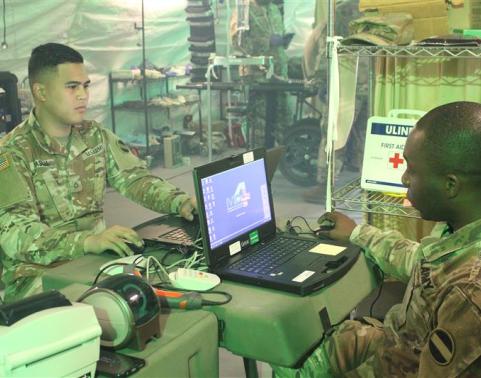MC4 prepares for transformation into Agile-focused OMIS-A

With nearly a quarter of a century of service to the U.S. Army, the Medical Communications for Combat Casualty Care (MC4) product office — part of Program Executive Office Enterprise Information Systems (PEO EIS) — is considered an old-timer in the acquisition world. Around five years ago, following deep-dive discussions among Army senior leaders, the decision was made to retire the program.
MC4’s software captures vital medical data for Soldiers in deployed environments, providing Army healthcare teams with an operational health information technology (OHIT) capability at all levels of care and informing Soldiers’ lifelong electronic health records. The software is a combination of government and commercial off-the-shelf solutions (GOTS/COTS) developed by MC4 and the Joint Operational Medicine Information Systems (JOMIS), a program that reports to Program Executive Office Defense Healthcare Management Systems within the Office of the Under Secretary of Defense for Acquisition and Sustainment.
After determining the significance of OHIT capabilities to the Army, the Army Futures Command jumped into action by facilitating Army adoption of the Joint Theater Medical Information Requirement (TMIR) to modernize Army OHIT capabilities to meet the needs of the Army of 2030.
According to Steve Reichard, MC4 product lead, the Army’s adoption of the TMIR paved the way for the launch of Operational Medical and Information System – Army (OMIS-A), a new acquisition program using the Software Acquisition Pathway and Agile processes to develop and deliver modernized OHIT solutions to Soldiers.
The original plan, said Reichard, was for MC4 to sunset on Sept. 30, 2023 and OMIS-A to make its debut Oct. 1; however, since OMIS-A is a “new start” program, the transition has been postponed until the Fiscal Year 2024 Defense Appropriations Act is signed. In the interim, the MC4 team has been taking steps to prepare for its modernization mission.
There are several key differences between the current and future programs. MC4 is a traditional Major Capability Acquisition program responsible for centrally providing managed hardware and worldwide field service representatives (FSRs) who provide full-service software deployment, system administrative support and in-person training. FSRs have played a vital role in OHIT support in theater for the past 20 years.
Moving into the future, OMIS-A will remotely deliver software, provide computer-based training courses supplemented with virtual training sessions, and provide help desk support rather than FSRs outside of the continental United States. Units will be responsible for procuring and supporting OHIT hardware, as well as conducting all system administrative functions for OHIT software.
Additionally, like many other PEO EIS programs, the future OMIS-A program will use a Scaled Agile Framework (SAFe) 6.0 Agile approach to software development and deployment. Leaders of the product office have completed SAFe 6.0 Agile training and are in the process of developing an acquisition strategy utilizing the SAFe 6.0 framework, said Reichard.
Like MC4, OMIS-A will continue to test and integrate JOMIS COTS solutions, develop GOTS software and field network-ready OHIT capabilities to Soldiers worldwide. These capabilities will support five operational healthcare functions: healthcare delivery, patient movement, medical logistics, medical command and control, and medical situational awareness. Ultimately, OMIS-A will help maximize return-to-duty rates, overcome contested logistics challenges, provide a complete medical common operating picture, enable real-time patient monitoring and manage patient information/data from point of need/injury across the continuum of care.
While MC4 will soon be retired and OMIS-A will be the new kid on the block, some things will remain the same. The product office and team will remain based at Fort Detrick, Maryland and will continue to be part of PEO EIS’s Integrated Personnel and Pay System – Army (IPPS-A) portfolio. Most importantly, the team’s dedication to the mission and Soldiers will remain strong.
“The Army Acquisition Corps patch has both an Alpha and an Omega on it, recognizing that programs have both a beginning and an end,” said Reichard. “We are excited to experience the totality of the program lifecycle with the transition from MC4 to OMIS-A, while continuing to provide this critical capability to the warfighter.”
Related News
-
Allison Gregory excels at contracting — and crafting
June 17, 2025As the contracts management division chief for Integrated Personnel and Pay System – Army at PEO Enterprise, Allison Gregory is responsible for guiding acquisition strategies that support big-picture goals, making sure the right contracts are in place when they’re needed and ensuring software deliverables are high quality and mission ready. -
Inside BATDOK-J’s Soldier Touchpoint
April 28, 2025Soldiers at Fort Campbell’s 3rd Mobile Brigade Combat Team of the 101st Airborne Division (Air Assault) experimented with the Battlefield Assisted Trauma Distributed Observation Kit-Joint (BATDOK-J) application during a 21-day Soldier Touchpoint that started March 18. Soldiers assessed how BATDOK-J integrates with the Army’s Health Assessment Lite Operations (HALO) electronic health record under realistic, operational environments. -
8 questions with IPPS-A's Sabrina Simpson
March 4, 2025For Sabrina Simpson, every day is an opportunity to combine her love of numbers with her passion for supporting Soldiers.
Work for Us
Join a winning team! Search for job opportunities with PEO Enterprise.
Work with Us
Help support important missions. Explore ways your company can work with PEO Enterprise.